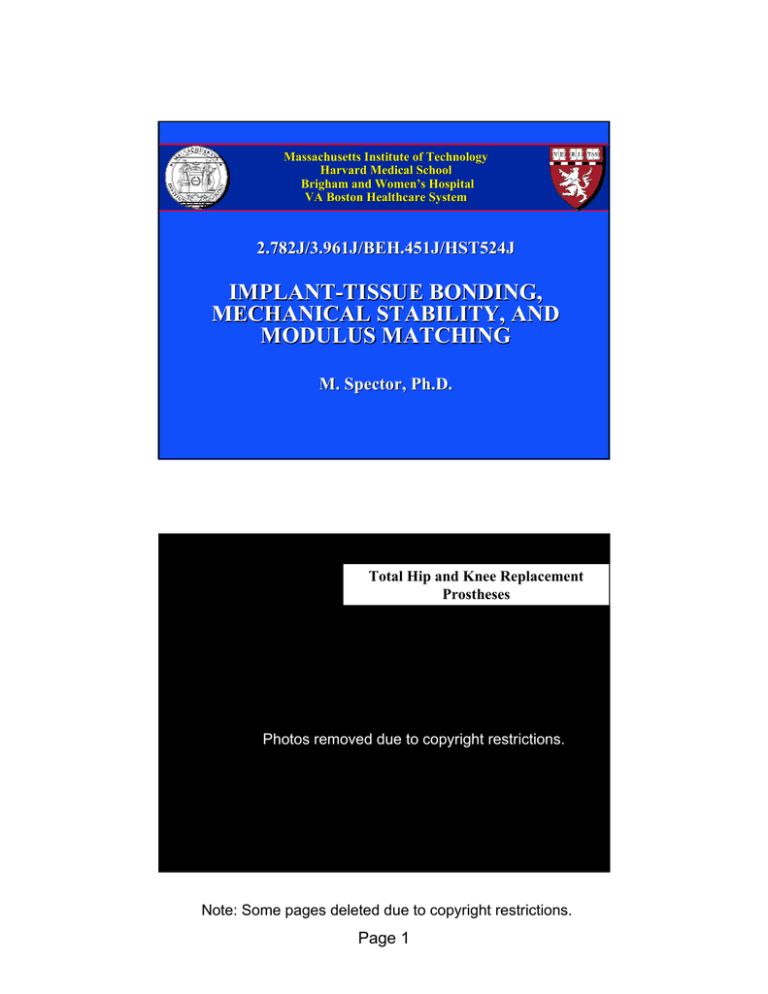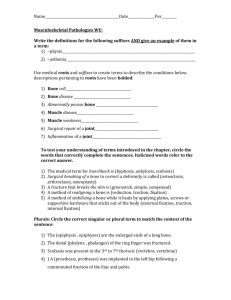Document 13612262
advertisement

Massach usetts Massachu setts Ins Institute of Technolo Technology Harva Harvarrd Me Medical dical School hool Brig ham m an Brigha and Women men’s Ho Hospital VA Bo thca are Sy Boston Heal Healthc System 2.782J/3.961J/BEH.451J/HST524J IMPLANT-TISSUE BONDING, MECHANICAL STABILITY, AND MODULUS MATCHING M. Spector, Ph.D. Total Hip and Knee Replacement Prostheses Photos removed due to copyright restrictions. Note: Some pages deleted due to copyright restrictions. Page 1 JOINT REPLACEMENT PROSTHESES DESIGN PRINCIPLES • Restoration of Kinematics – Range of motion • Restoration of Joint Mechanics – Limb length (THA) – Angulation (TKA) – Vector of muscle force (abductor and patella) • Mechanical Stability (Fit, Fixation, and Stiff.) • Wear (and Friction) of the Articulation FACTORS INFLUENCING PERFORMANCE Micromotion1 Stress Shielding2 Fit Fixation Stiffness 1 2 pain bone loss FACTORS INFLUENCING PERFORMANCE Fit • Size and Shape – Computer-designed based on radiographs (viz., CTs) for standardiz ed or individualized standardized individualized femoral stems; P.S. Walker – “Identifit”: a silicone mold used to intraoperatively construct a cementless femoral stem. FACTORS INFLUENCING PERFORMANCE: FIT ht tp://www.scp.no http ://www.scp.no Courtesy of Scandinavian Customized Prosthesis as. Used with permission. FACTORS INFLUENCING PERFORMANCE: FIT “Identifit” • The surgeon creates the cavity in the femur. • A silicone mold of the cavity in the femoral canal is made. • While the surgeon proceeds to insert the acetabulum, in a laboratory located annexed to the hospital the mold is used use to make a titanium stem in the same shape. • The stem is anatomical with a mean value for bone to prosthesis contact equal to 94%. V Salvi, 4):443-5 -5 Salvi, Chir Organi Mov. Mov. 1992 1992 Oct-Dec;77( Oct-Dec;77(4):443 FACTORS INFLUENCING PERFORMANCE Micromotion1 Stress Shielding2 Fit Fixation Stiffness 1 2 pain bone loss IMPLANT FIXATION TISSUE INTEGRATION/TISSUE BONDING • Cement • Biological Fixation PMMA “Bone Cement” Self-Curing Polymethylmethacrylate Photos removed due to copyright restrictions. Problems with PMMA •Low strength •Exothermic reaction •Toxic monomer Bone PMMA TYPES OF BIOLOGICAL FIXATION • Friction al forces acting on a smooth Frictional smooth surface (press-fit) • Mechanical bond due to interdigitation of o bone with irregular surface • Interlocking mechanical bond due to bone ingrowth into porous coating • Chemical bond of bone adhesion to calcium phosphate coating MECHANICAL CHARACTERISTICS OF BIOLOGICAL FIXATION Shear Strength Strength Smooth Surface Press-Fit Irregular Surface Porous Coating Cal. Phos. Coating Tensile + 0 ++ +++ +++ 0 ++ +++ PROBLEMS OF BIOLOGICAL FIXATION Problem Smooth Surface (Press-fit) Irregular Surface Porous Coating Cal. Phos. Coating Design/implantation that yields an interference fit Obtaining sufficient bone apposition Obtaining sufficient bone ingrowth Detachment/absorption of coating FUNCTION OF POROUS COATING • Assist in stabilization Not the primary means of stabilization (inherent mechanical stability of the design) • Serve as rasp to enhance initial stability BIOLOGY OF BONE INGROWTH • Bone heals by regeneration • Excessive movement of implant (>150µm) can ca disrupt stroma, resulting in repair w ith scar (fibrous with encapsulation of implant and fibrous ingrowth) • Pore size must accommodate OBs (15-20µm), capillaries (10µm), and matrix; (pore size > 100 µm) • Temporal sequence: – Bone ingrowt ingrowth < 4– 4–8 wk wks – Remodeling > 8 wk wks (stress re related lated)) M. Spect Spector, in in Noncemented Total Hip Arthro gera ald, Raven Arthroplasty plasty (Ed. R. Fitz Fitzger Raven Press Press)) 1988 BIOLOGY OF BONE INGROWTH Weeks Implantation Implantation Blood Clot Granulatio n Granulation (Osteoprogenitor Mesenchyme) Motion: Disruption of Stroma 1 Regeneration of Bone (Ingrow (Ingrowth Phase) 10 Stress Adaptive Remodeling Repair (Scar) (Scar) FACTORS AFFECTING BONE INGROWTH Prosthetic Design Factors Mechanical Stabilization Pore Characteristics Bone Ingrowth Host Factors Available Bone Stock Disease Aging Adjuvant Therapies ie Bone graft material Synthetic calcium phosphate Collagen implants Demineralized bone matrix Bone growth factors factor Electricity Photos removed due to copyright restrictions. EVALUATION OF BONE BONDING TO HA-COATED PROSTHESES • To evaluate the percentages of hydroxyapatite (HA) and titanium surfaces to which bone was bonded, on HA-coated and non-coated titanium femoral stems retrieved from human subjects. • Work was prompted by the supposition that as HA coatings dissolve or detach from the titanium substrate, the exposed metal becomes osseointegrated so as to maintain the fixation to bone. MATERIALS AND METHODS • Six implants used in this study from patients treated for a fractured femoral neck with a Bimetric hemi-arthroplasty (Biomet, UK). –3 HA-coated specimens (duration 173, 261 and 660 days, post-op) –3 non-coated specimens (40, 650 and 1094 days) • The plasma-sprayed HA coating had an average crystallinity >85% and an average thickness of 50µm. ESEM of a non-HA­ coated specimen retrieved 40 days after implantation Photos removed due to copyright restrictions. A. Porter ESEM of a non-HA-coated stem after 1094 days Photos removed due to copyright restrictions. A. Porter RESULTS • For the HA-coated stems: – 80±20% (mean±SEM, n=3) for the HA-coated regions versus 24±8% (n=3) for the titanium, originally underlying the HA and exposed with its loss (Student’s t test, p=0.01). • For the non-coated titanium stems: – 24±5%; n=3, comparable with the bonding to the titanium regions on the HA-coated stems exposed by the loss of HA . FACTORS INFLUENCING PERFORMANCE Micromotion1 Stress Shielding2 Fit Fixation Stiffness 1 2 pain bone loss Defect in the Proximal Tibia Filled with Particles of Synthetic Hydroxyapatite, 1yr f-u Failure Due to Lack of Modulus Matching Potential for breakdown of the overlying art. cart. due to high stiffness of the subchondral bone? Photos removed due to copyright restrictions. Region of high density and stiffness (cannot be drilled or sawn) Bone loss due to stress-shielding? Total Hip and Knee Replacement Prostheses Photos removed due to copyright restrictions. Bone Loss Due to Stress Shielding Around a Hip Prosthesis Photos removed due to copyright restrictions. Undersized stem did not fill the medullary canal; no fixation of bone to the smooth stem; radiographic sign of stem toggling in the femur; painful Revision stem fills the canal and is bonded to bone by its porous coating; x-ray sign of thinning of the cortical bone; not painful Normal thick. Bone Loss Due to Stress Shielding Around a Hip Prosthesis Prosthesis removed from a patient at the time of revision of Photos removed due to copyrighttime restrictions. Decrease in the Stress in the Distal Femur after TKA due to the Stiffness of the Co-Cr Femoral Component: Finite Element Analysis M. Angelides, et al., Trans. Orthop. Res. Soc., 13:475 (1988) Courtesy of Orthopaedic Research Society. Used with permission. Diagram removed due to copyright restrictions. RADIOGRAPHIC BONE LOSS AFTER TKA* • Retrospective radiographic analysis of 147 TKAs. – 3 designs – Cemented and porous-coated, non-cemented • Determination of whether bone loss was evident in the post-op radiographs. – 3 examiners * Mint nn S, Ewal Mintzer CM, CM, Robert Robertson DD, Rackema Rackeman Ewald FC, Scott Scott RD, Spector M. Bone loss in the dist oplas distal anterior anterior femur femur after total knee knee arthr arthro plastty. Clin Orth op.. 260:135 Orthop 60:135 (1990) (1990) Diagram removed due to copyright restrictions. Bone Loss Under the Femoral Component of a Total Knee Replacement Prosthesis: Stress Shielding Photos removed due to copyright restrictions. C.M. Mintzer, Mintzer, et al., al., Clin Orthop. Orthop. 260:135 (1990) BONE LOSS UNDER THE FEMORAL COMPONENT OF TKA • Bone loss occurred in the majority of cases (68% of patients). • Bone loss occurred within the first post-­ operative year and did not appear to progress. • Bone loss was independent of implant design and mode of fixation (i.e., cemented vs. non-cemented). C.M. C.M. Mint Mintzer, et al., al., Clin Clin Orth op.. 260:13 Orthop 60:135 (1990) (1990) EFFECT OF BONE LOSS ON BONE STRENGTH How much bone loss needs to occur before it is detectable in a radiograph? • Radiographic evidence of bone loss in the distal femur = 30% reduction in bone density.* How does bone loss affect bone strength? • Bone strength is proportional to density2. • Therefore a 30% decrease in bone density means a 50% decrease in bone strength. *D.D. *D.D. Ro Robert bertson et al al., J. Bo Bone Jt. 66 (1994) Jt. Surg Surg.. 76-A: 76-A:66 (1994) BONE LOSS UNDER THE FEMORAL COMPONENT OF TKA Conclusion • Bone loss occurs in the distal anterior femur post-TKA due to stress shielding related to the stiffness of the cobaltchromium alloy component C.M. C.M. Mint Mintzer, et al., al., Clin Clin Orth op.. 260:13 Orthop 60:135 (1990) (1990) BONE LOSS DUE TO STRESS SHIELDING • • • • Potential Problems Complicates revision arthroplasty due to the loss of bone stock. May place the prosthesis at risk for loosening. May place the distal femur at risk of fracture. Solution Oxinium TKA. – Oxinium has approximately ½ the stiffness of Co-Cr alloy, therefore there should be less stress shielding and less bone loss. Sketches of Radiographs Diagram removed due to copyright restrictions. BENDING STIFFNESS = Modulus x Cross Section of Elasticity Moment of Inertia = E x πD4/64 Diagrams of AML Prosthesis removed due to copyright restrictions. BENDING STIFFNESS = Modulus x Cross Section of Elasticity Moment of Inertia = E x πD4/64 Porous Polysulfone-Coated Titanium Femoral Stem πD4/64 Photo removed due to copyright restrictions. Photos removed due to copyright restrictions. Stems that reduce the cross-sectional moment of inertia Photos removed due to copyright restrictions. FACTORS INFLUENCING PERFORMANCE Micromotion1 Stress Shielding2 Fit Fixation Stiffness ? 1 2 pain bone loss






